Xu Tang
ASM-UNet: Adaptive Scan Mamba Integrating Group Commonalities and Individual Variations for Fine-Grained Segmentation
Aug 10, 2025Abstract:Precise lesion resection depends on accurately identifying fine-grained anatomical structures. While many coarse-grained segmentation (CGS) methods have been successful in large-scale segmentation (e.g., organs), they fall short in clinical scenarios requiring fine-grained segmentation (FGS), which remains challenging due to frequent individual variations in small-scale anatomical structures. Although recent Mamba-based models have advanced medical image segmentation, they often rely on fixed manually-defined scanning orders, which limit their adaptability to individual variations in FGS. To address this, we propose ASM-UNet, a novel Mamba-based architecture for FGS. It introduces adaptive scan scores to dynamically guide the scanning order, generated by combining group-level commonalities and individual-level variations. Experiments on two public datasets (ACDC and Synapse) and a newly proposed challenging biliary tract FGS dataset, namely BTMS, demonstrate that ASM-UNet achieves superior performance in both CGS and FGS tasks. Our code and dataset are available at https://github.com/YqunYang/ASM-UNet.
ACMamba: Fast Unsupervised Anomaly Detection via An Asymmetrical Consensus State Space Model
Apr 16, 2025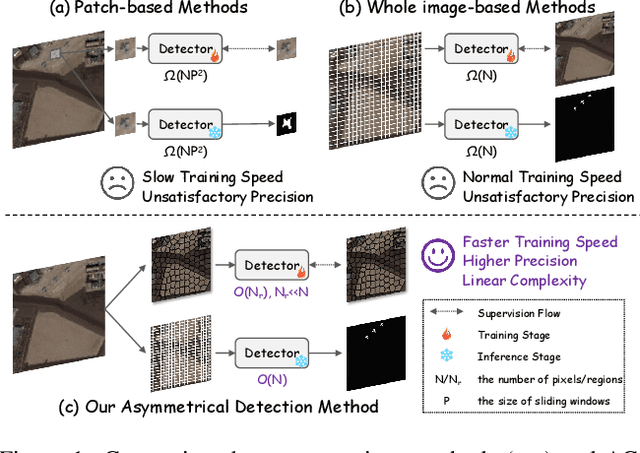
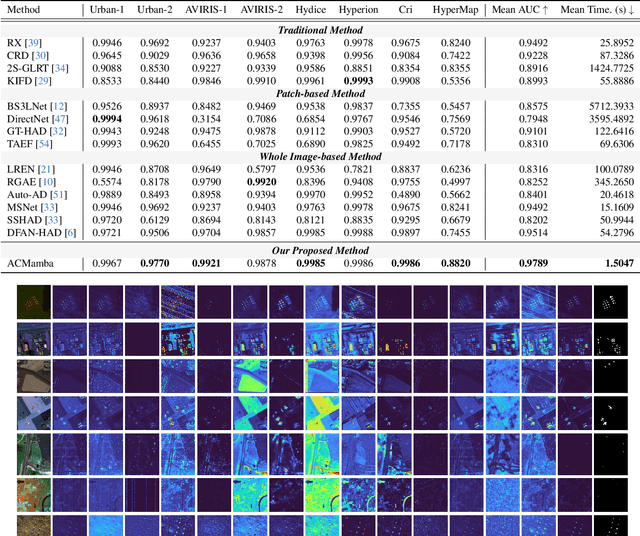
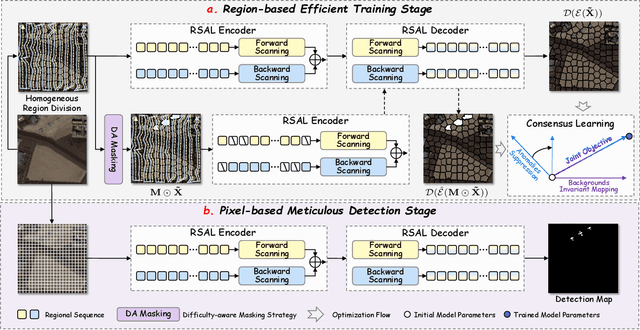
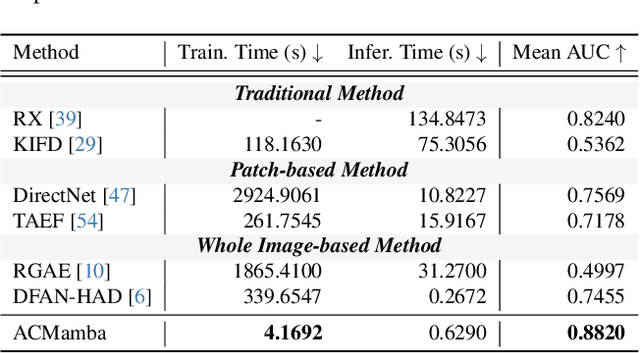
Abstract:Unsupervised anomaly detection in hyperspectral images (HSI), aiming to detect unknown targets from backgrounds, is challenging for earth surface monitoring. However, current studies are hindered by steep computational costs due to the high-dimensional property of HSI and dense sampling-based training paradigm, constraining their rapid deployment. Our key observation is that, during training, not all samples within the same homogeneous area are indispensable, whereas ingenious sampling can provide a powerful substitute for reducing costs. Motivated by this, we propose an Asymmetrical Consensus State Space Model (ACMamba) to significantly reduce computational costs without compromising accuracy. Specifically, we design an asymmetrical anomaly detection paradigm that utilizes region-level instances as an efficient alternative to dense pixel-level samples. In this paradigm, a low-cost Mamba-based module is introduced to discover global contextual attributes of regions that are essential for HSI reconstruction. Additionally, we develop a consensus learning strategy from the optimization perspective to simultaneously facilitate background reconstruction and anomaly compression, further alleviating the negative impact of anomaly reconstruction. Theoretical analysis and extensive experiments across eight benchmarks verify the superiority of ACMamba, demonstrating a faster speed and stronger performance over the state-of-the-art.
LexPam: Legal Procedure Awareness-Guided Mathematical Reasoning
Apr 03, 2025Abstract:The legal mathematical reasoning ability of LLMs is crucial when applying them to real-world scenarios, as it directly affects the credibility of the LLM. While existing legal LLMs can perform general judicial question answering, their legal mathematical reasoning capabilities have not been trained. Open-domain reasoning models, though able to generate detailed calculation steps, do not follow the reasoning logic required for legal scenarios. Additionally, there is currently a lack of legal mathematical reasoning datasets to help validate and enhance LLMs' reasoning abilities in legal contexts. To address these issues, we propose the first Chinese legal Mathematical Reasoning Dataset, LexNum, which includes three common legal mathematical reasoning scenarios: economic compensation, work injury compensation, and traffic accident compensation. Based on LexNum, we tested the performance of existing legal LLMs and reasoning LLMs, and introduced LexPam, a reinforcement learning algorithm guided by legal procedural awareness to train LLMs, enhancing their mathematical reasoning abilities in legal scenarios. Experiments on tasks in the three legal scenarios show that the performance of existing legal LLMs and reasoning models in legal mathematical reasoning tasks is unsatisfactory. LexPam can enhance the LLM's ability in these tasks.
MEET: A Million-Scale Dataset for Fine-Grained Geospatial Scene Classification with Zoom-Free Remote Sensing Imagery
Mar 14, 2025Abstract:Accurate fine-grained geospatial scene classification using remote sensing imagery is essential for a wide range of applications. However, existing approaches often rely on manually zooming remote sensing images at different scales to create typical scene samples. This approach fails to adequately support the fixed-resolution image interpretation requirements in real-world scenarios. To address this limitation, we introduce the Million-scale finE-grained geospatial scEne classification dataseT (MEET), which contains over 1.03 million zoom-free remote sensing scene samples, manually annotated into 80 fine-grained categories. In MEET, each scene sample follows a scene-inscene layout, where the central scene serves as the reference, and auxiliary scenes provide crucial spatial context for finegrained classification. Moreover, to tackle the emerging challenge of scene-in-scene classification, we present the Context-Aware Transformer (CAT), a model specifically designed for this task, which adaptively fuses spatial context to accurately classify the scene samples. CAT adaptively fuses spatial context to accurately classify the scene samples by learning attentional features that capture the relationships between the center and auxiliary scenes. Based on MEET, we establish a comprehensive benchmark for fine-grained geospatial scene classification, evaluating CAT against 11 competitive baselines. The results demonstrate that CAT significantly outperforms these baselines, achieving a 1.88% higher balanced accuracy (BA) with the Swin-Large backbone, and a notable 7.87% improvement with the Swin-Huge backbone. Further experiments validate the effectiveness of each module in CAT and show the practical applicability of CAT in the urban functional zone mapping. The source code and dataset will be publicly available at https://jerrywyn.github.io/project/MEET.html.
FireRedASR: Open-Source Industrial-Grade Mandarin Speech Recognition Models from Encoder-Decoder to LLM Integration
Jan 24, 2025



Abstract:We present FireRedASR, a family of large-scale automatic speech recognition (ASR) models for Mandarin, designed to meet diverse requirements in superior performance and optimal efficiency across various applications. FireRedASR comprises two variants: FireRedASR-LLM: Designed to achieve state-of-the-art (SOTA) performance and to enable seamless end-to-end speech interaction. It adopts an Encoder-Adapter-LLM framework leveraging large language model (LLM) capabilities. On public Mandarin benchmarks, FireRedASR-LLM (8.3B parameters) achieves an average Character Error Rate (CER) of 3.05%, surpassing the latest SOTA of 3.33% with an 8.4% relative CER reduction (CERR). It demonstrates superior generalization capability over industrial-grade baselines, achieving 24%-40% CERR in multi-source Mandarin ASR scenarios such as video, live, and intelligent assistant. FireRedASR-AED: Designed to balance high performance and computational efficiency and to serve as an effective speech representation module in LLM-based speech models. It utilizes an Attention-based Encoder-Decoder (AED) architecture. On public Mandarin benchmarks, FireRedASR-AED (1.1B parameters) achieves an average CER of 3.18%, slightly worse than FireRedASR-LLM but still outperforming the latest SOTA model with over 12B parameters. It offers a more compact size, making it suitable for resource-constrained applications. Moreover, both models exhibit competitive results on Chinese dialects and English speech benchmarks and excel in singing lyrics recognition. To advance research in speech processing, we release our models and inference code at https://github.com/FireRedTeam/FireRedASR.
DynamicFace: High-Quality and Consistent Video Face Swapping using Composable 3D Facial Priors
Jan 15, 2025



Abstract:Face swapping transfers the identity of a source face to a target face while retaining the attributes like expression, pose, hair, and background of the target face. Advanced face swapping methods have achieved attractive results. However, these methods often inadvertently transfer identity information from the target face, compromising expression-related details and accurate identity. We propose a novel method DynamicFace that leverages the power of diffusion model and plug-and-play temporal layers for video face swapping. First, we introduce four fine-grained face conditions using 3D facial priors. All conditions are designed to be disentangled from each other for precise and unique control. Then, we adopt Face Former and ReferenceNet for high-level and detailed identity injection. Through experiments on the FF++ dataset, we demonstrate that our method achieves state-of-the-art results in face swapping, showcasing superior image quality, identity preservation, and expression accuracy. Besides, our method could be easily transferred to video domain with temporal attention layer. Our code and results will be available on the project page: https://dynamic-face.github.io/
Single Trajectory Distillation for Accelerating Image and Video Style Transfer
Dec 25, 2024



Abstract:Diffusion-based stylization methods typically denoise from a specific partial noise state for image-to-image and video-to-video tasks. This multi-step diffusion process is computationally expensive and hinders real-world application. A promising solution to speed up the process is to obtain few-step consistency models through trajectory distillation. However, current consistency models only force the initial-step alignment between the probability flow ODE (PF-ODE) trajectories of the student and the imperfect teacher models. This training strategy can not ensure the consistency of whole trajectories. To address this issue, we propose single trajectory distillation (STD) starting from a specific partial noise state. We introduce a trajectory bank to store the teacher model's trajectory states, mitigating the time cost during training. Besides, we use an asymmetric adversarial loss to enhance the style and quality of the generated images. Extensive experiments on image and video stylization demonstrate that our method surpasses existing acceleration models in terms of style similarity and aesthetic evaluations. Our code and results will be available on the project page: https://single-trajectory-distillation.github.io.
Beyond Guilt: Legal Judgment Prediction with Trichotomous Reasoning
Dec 19, 2024



Abstract:In legal practice, judges apply the trichotomous dogmatics of criminal law, sequentially assessing the elements of the offense, unlawfulness, and culpability to determine whether an individual's conduct constitutes a crime. Although current legal large language models (LLMs) show promising accuracy in judgment prediction, they lack trichotomous reasoning capabilities due to the absence of an appropriate benchmark dataset, preventing them from predicting innocent outcomes. As a result, every input is automatically assigned a charge, limiting their practical utility in legal contexts. To bridge this gap, we introduce LJPIV, the first benchmark dataset for Legal Judgment Prediction with Innocent Verdicts. Adhering to the trichotomous dogmatics, we extend three widely-used legal datasets through LLM-based augmentation and manual verification. Our experiments with state-of-the-art legal LLMs and novel strategies that integrate trichotomous reasoning into zero-shot prompting and fine-tuning reveal: (1) current legal LLMs have significant room for improvement, with even the best models achieving an F1 score of less than 0.3 on LJPIV; and (2) our strategies notably enhance both in-domain and cross-domain judgment prediction accuracy, especially for cases resulting in an innocent verdict.
DaYu: Data-Driven Model for Geostationary Satellite Observed Cloud Images Forecasting
Nov 15, 2024Abstract:In the past few years, Artificial Intelligence (AI)-based weather forecasting methods have widely demonstrated strong competitiveness among the weather forecasting systems. However, these methods are insufficient for high-spatial-resolution short-term nowcasting within 6 hours, which is crucial for warning short-duration, mesoscale and small-scale weather events. Geostationary satellite remote sensing provides detailed, high spatio-temporal and all-day observations, which can address the above limitations of existing methods. Therefore, this paper proposed an advanced data-driven thermal infrared cloud images forecasting model, "DaYu." Unlike existing data-driven weather forecasting models, DaYu is specifically designed for geostationary satellite observations, with a temporal resolution of 0.5 hours and a spatial resolution of ${0.05}^\circ$ $\times$ ${0.05}^\circ$. DaYu is based on a large-scale transformer architecture, which enables it to capture fine-grained cloud structures and learn fast-changing spatio-temporal evolution features effectively. Moreover, its attention mechanism design achieves a balance in computational complexity, making it practical for applications. DaYu not only achieves accurate forecasts up to 3 hours with a correlation coefficient higher than 0.9, 6 hours higher than 0.8, and 12 hours higher than 0.7, but also detects short-duration, mesoscale, and small-scale weather events with enhanced detail, effectively addressing the shortcomings of existing methods in providing detailed short-term nowcasting within 6 hours. Furthermore, DaYu has significant potential in short-term climate disaster prevention and mitigation.
Target-Driven Distillation: Consistency Distillation with Target Timestep Selection and Decoupled Guidance
Sep 02, 2024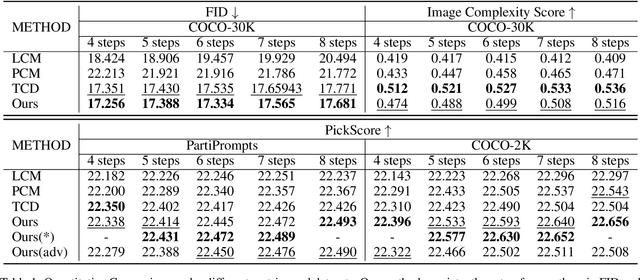
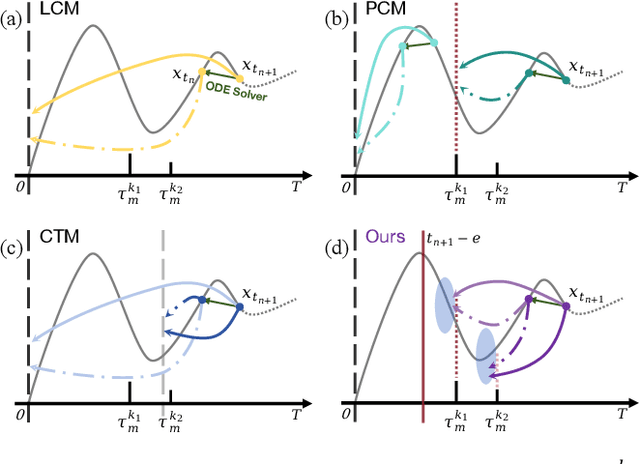
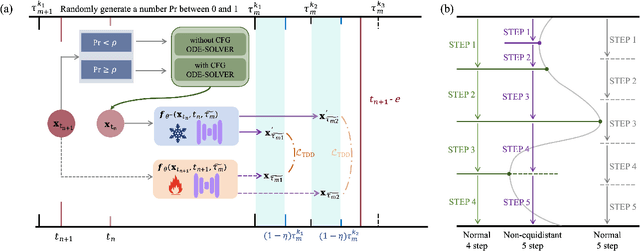
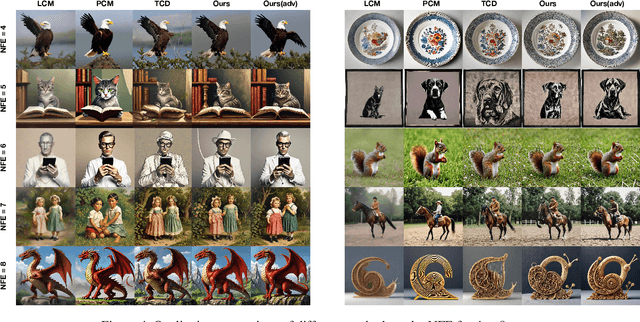
Abstract:Consistency distillation methods have demonstrated significant success in accelerating generative tasks of diffusion models. However, since previous consistency distillation methods use simple and straightforward strategies in selecting target timesteps, they usually struggle with blurs and detail losses in generated images. To address these limitations, we introduce Target-Driven Distillation (TDD), which (1) adopts a delicate selection strategy of target timesteps, increasing the training efficiency; (2) utilizes decoupled guidances during training, making TDD open to post-tuning on guidance scale during inference periods; (3) can be optionally equipped with non-equidistant sampling and x0 clipping, enabling a more flexible and accurate way for image sampling. Experiments verify that TDD achieves state-of-the-art performance in few-step generation, offering a better choice among consistency distillation models.
 Add to Chrome
Add to Chrome Add to Firefox
Add to Firefox Add to Edge
Add to Edge